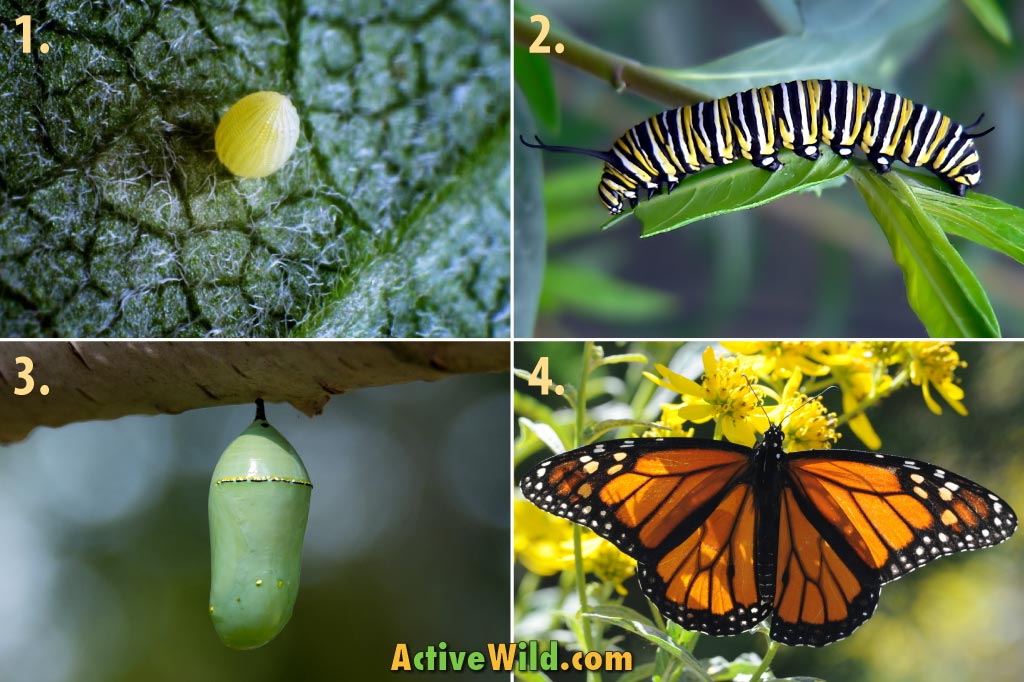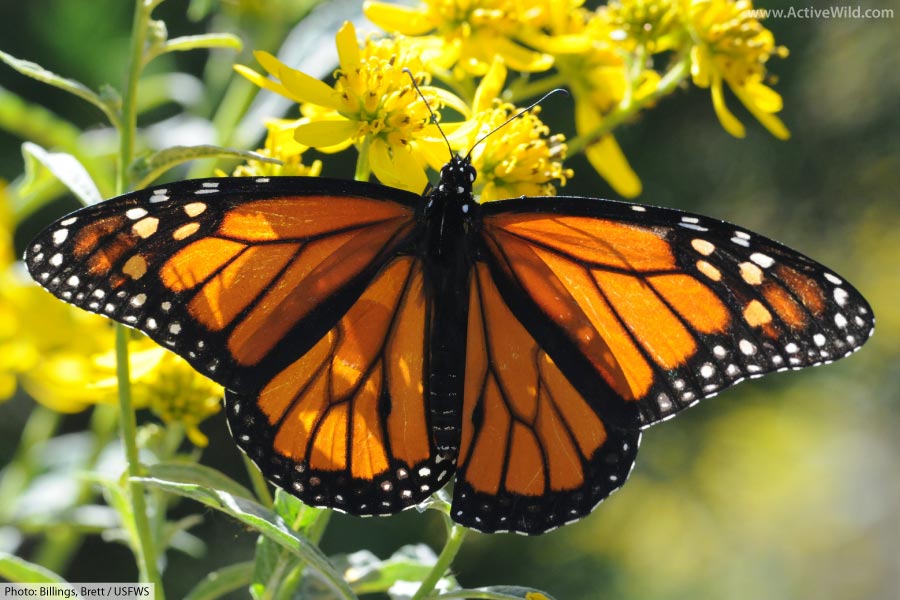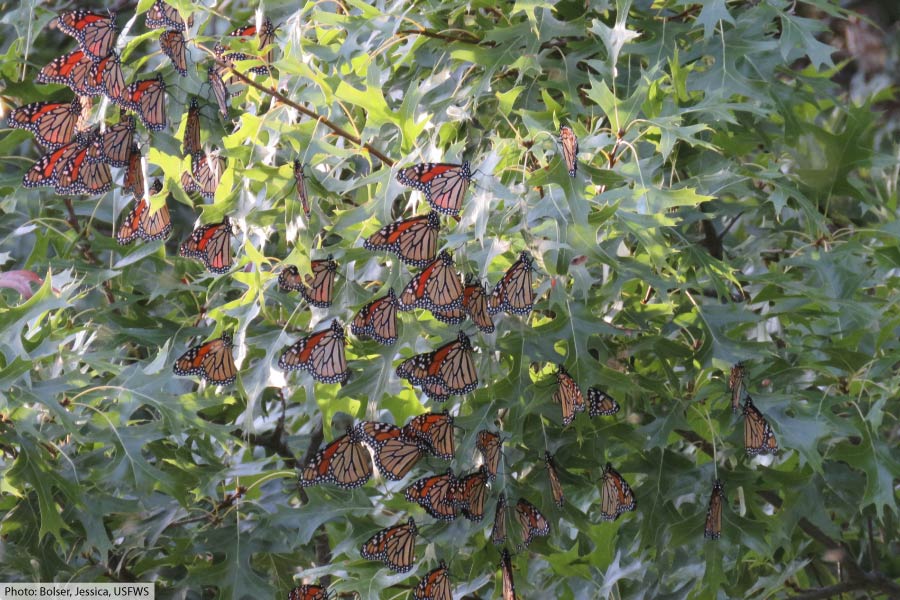A detailed look at the life cycle of the monarch butterfly, with pictures and facts. Discover how the monarch butterfly combines its four-stage life cycle with one of the longest migrations of the insect world…
The Life Cycle Of The Monarch Butterfly
The monarch butterfly is one of the best-known butterfly species of North America. With its black-veined, orange-paneled wings, this large insect is a familiar sight across the United States, southern Canada and Mexico.
What makes the monarch butterfly particularly interesting is that it combines the usual four-stage butterfly life cycle with one of the longest migrations of the insect world. Individual monarch butterflies are known to travel thousands of miles in their fall migration.
Monarch Butterfly Life Stages
As with all butterflies, there are four main stages in the monarch butterfly life cycle:
(You can click on any of the stages below to go to the relevant part of the page.)
Monarch Migration
In order to fully understand the life cycle of the monarch butterfly, we first need to take a look at the insect’s migratory pattern.
The monarch migration begins in mid-August, when monarch butterflies living in Canada and the United States begin to migrate south to the southern United States and Mexico, where the species overwinters.
During the species’ annual migration south, individual butterflies are known to travel up to 3,000 miles from Canada to Mexico.
Millions of monarch butterflies take part in the migration, making it one of the world’s most impressive natural spectacles.
The return migration takes place in spring, usually beginning in March. Unlike the journey south, the northward trip is taken in stages, with no single butterfly making the entire journey.
Instead, the journey is split between multiple generations.
It may be the great-grandchildren of a monarch butterfly that hatched in Mexico that finally return to the northernmost regions of the butterfly’s range.
Monarchs living in more southerly regions may complete their northerly migration over two generations.
Monarch Butterfly Lifespan
Whereas the entire life cycle of a northward-traveling monarch butterfly takes only between 2 to 5 weeks to complete, the lifespan of a southward-migrating monarch butterfly can be as long as 8 to 9 months.
Monarch Butterfly Life Cycle
As with all butterflies, there are four main stages in the monarch butterfly’s life cycle: egg; larva (caterpillar); pupa (chrysalis); imago (adult butterfly). We’ll find out more about each of the stages below:
Egg
Female monarch butterflies each lay around 300 to 1,000 eggs. The eggs are laid individually on the undersides of the leaves of milkweed plants. They are oval-shaped, around 1mm in height, and white / pale cream in color.
Monarch butterfly eggs take from 3 to 5 days to hatch.
Larva (Caterpillar)
The larval stage of a butterfly is known as a caterpillar.
After hatching, the tiny (0.8 – 0.23 in. / 2 – 6 mm) monarch caterpillar eats what remains of its egg, then turns its attention to the milkweed leaf.
Monarch caterpillars only eat milkweed, which is why it is important that these plants, which are often treated as weeds, are planted and conserved.
Milkweed leaves aren’t only important as a food source; they also contain chemicals known as cardenolides which make the caterpillar distasteful to predators.
These toxic chemicals stay in the monarch’s body even in its adult form. The butterfly’s bright orange color warns potential predators of its toxicity.
As well as its six true legs, the monarch caterpillar has five pairs of 'false' legs, known as 'prolegs'. These are equipped with tiny hooks for holding onto surfaces. The tentacles at either end of the caterpillar's body are sense organs.
The monarch caterpillar sheds its skin (a process known as a molt, or moult in British English) five times. At the fifth molt the insect enters its pupal stage. The stages between molts are known as an ‘instars’. The first instar is the newly-hatched caterpillar, the second instar is the caterpillar after its first molt, and so on.
Each successive instar is larger than the previous instar and slightly different in appearance. By the fifth and final instar the monarch caterpillar is between 1 and 1.8 in. (2.5 and 4.5 cm) in length.
You can find out more about these stages (and see pictures of caterpillars in each stage) on this page: Monarch Caterpillar Stages
The larval stage of the monarch butterfly life cycle takes from 10 to 14 days.
Pupa (Chrysalis)
The pupal stage of a butterfly is known as a chrysalis.
When ready to pupate, the monarch caterpillar attaches itself to the underside of a leaf or other surface with a sticky silk pad. It hangs upside-down and sheds its yellow and black skin, revealing the leaf-green protective shell of the chrysalis underneath.
The chrysalis’s green color provides camouflage against the foliage. Prior to hatching, the chrysalis becomes transparent, allowing the adult butterfly’s colors to be seen.
As the monarch butterfly metamorphoses into its adult form, the chrysalis can be seen to make slight movements.
The pupal stage of the life cycle of the monarch butterfly lasts from 10 to 14 days.
Imago (Adult Butterfly)
The transparent chrysalis splits open and the adult butterfly finally emerges. After hatching the butterfly has to wait for its wings to dry out and become fully extended before it can fly away in search of nectar.
Although the adult butterfly does not do any more growing, it still has to feed in order to acquire energy.
Unlike the caterpillars, which feed only on milkweeds, the adult monarchs feed on a variety of nectar-producing plants.
Unless a member of the south-migrating generation, a monarch butterfly takes from 4 to 5 days to reach sexual maturity and lives in its adult form for between 2 and 5 weeks.
Members of the southward-migrating generation of monarch butterflies have a much longer total lifespan of 8 to 9 months, and will not start mating until spring.
Before mating, males pursue females in the air. Mating takes place on the ground, with male and female butterflies remaining attached to one another for between 30 minutes to an hour.
Both males and females will mate several times with different partners. Egg-laying takes place shortly after mating has occurred.
At this point the life cycle of the monarch butterfly is complete.
You can find out more about monarch butterflies on this page: Monarch Butterfly Facts
Discover More with Active Wild
- Discover an endangered US insect: Rusty-Patched Bumblebee Facts
- Become an animal expert: The Animal Kingdon Ultimate Guide
- Discover amazing animals from all around the world: A to Z Animals











I’m in mid-Missouri. Last week I found 6 on my new butterfly milkweed in my pollinator garden I planted this year. By Sunday it was 13 and the plants didn’t seem big enough to sustain them so I cut some branches and took them to a giant pollinator garden at a nearby state park. I kept one behind on a plant with plenty of leaves left. Over an inch so maybe gonna pupate soon. I am assuming this is probably a southbound bunch – Otherwise kinda late to be born in Missouri? How long after they emerge before they can migrate?
I live in wisconsin and been collecting caterpillars now for about 6 years. when i was doing day care we found one and i sent a picture to my husband who was very interested in butterflies as a boy. so he told yes this is a monach. so the kids and i watch it grow and the even got to see it come out of the crysillis. I ran over to video tape it. I showed a friend last fall and her and I both are collecting them. She calls them her kids. So I have 23 that turned into the crysilis and many yet small on the bottom. Last week before our first camping I went where I threw the dry milk weed out and found 12 little one that had hatched. So put them in the netted cage. As we were camping on trails found 5 more and Found 4 today. It is so enjoyable to watch them. So cant wait for them to turn into butterflies. because last year was a year we started collecting the eggs before the plants got cut down. our news channel did a piece on what to look for and so this we have had them from when you could barely see them.
I’m in south Florida and understand the monarchs do not migrate south for the winter. I keep about 2 dozen milkweed plants around for them to lay their eggs and eat from. Question, does the larva or egg sensitive to the cold weather here in the south. I have about 14 lava’s and several eggs that have not hatch, do I need to keep them inside during cold snaps under 40* F
Hi John, I live in Miami, and I would like to plant milkweed plant in my garden. Where can I get it?
Hi Maria,
Thank you for your comment. Hopefully a Floridian will be along shortly to recommend somewhere that stocks milkweed plants and/or seeds.
Milkweed species native to Florida include:
(Some argue that planting non-native species, such as tropical milkweed Asclepias curavassica (which may have different growing / flowering times, etc.) can be detrimental to monarch populations in the long-term.)
If anyone in the Miami region knows of a grower / nursery / store that stocks native milkweed plants – or has tips for growing milkweed for monarchs – then please feel free to comment!
Regards,
The Active Wild Team
I have news, I found four large ones on my parsley plant and they we’re eating it nearly bare. They were very large I put them on a near by crepe myrtle. I hope they make it, but they do like parsley.
Unfortunately, that isn’t a monarch. Monarch only live on Milkweed.
Likely swallowtails. Great!
I live in Orlando and have purchased milkweed plants at Lowes. Most nursery’s should have it available. Lowes has a good supply right now, so check your local store and hopefully they will have it. I bought 4 plants and planted them all together. Within 2 weeks I have 2 caterpillars! They are eating like crazy on the leafs. Friend tells me they will eat all the leaves and you’re left with sticks. Leave it alone and next year the foliage will come back.
Hi,
Thank you for your comment, and congratulations on your caterpillars!
Regards,
The Active Wild Team
How long is the monarch in the pupal stage? Do they winter over in the pupal stage?
If we see monarchs during the summer, are they different butterflies just passing through on their migration?
Hi Debra,
The reproductive patterns of monarch butterflies are to an extent influenced by the temperature. Because the fall months seem to be getting warmer, it’s not too unusual to see late season monarch caterpillars in October, and even into November.
There’s every chance that your caterpillars will successfully hatch and continue their migration south.
Regards,
The Active Wild Team
I have about 12 monarch caterpillars on my butterfly weed plants. It is already October and aren’t they supposed to be migrating?
How many different “colors” does the egg change to before hatching?
How many kinds of milk weed are there? and which is the Monarch’s favorite?
Hi Abe,
That’s a great question. Milkweeds are any plant of genus Asclepias. There are over 200 Asclepias species of milkweed, but not all are found in the U.S. Monarchs will likely be happy with any native milkweed, but below is a list of tried and tested species:
Milkweeds known to be suitable for monarchs include: Butterfly Weed (Asclepias tuberosa); California Milkweed (Asclepias californica); Common Milkweed (Asclepias syriaca); Purple Milkweed (Asclepias purpurascens); Showy Milkweed (Asclepias speciosa); Swamp Milkweed (Asclepias incarnata); and Whorled Milkweed (Asclepias verticillata).
We hope this helps!
Regards,
The Active Wild Team
I’m in South Florida and I have Monarchs every year. At this time,April, I am now seeing 5 or 6 caterpillars on my milkweeds. At about this time and even a little earlier the seeds of the beautiful milkweeds start to drop. They are clustered in a seed pod. Each year I take the seeds out of the pods and plant them in starter pots, they grow so easily and I end up placing them all over the place (they like sun and watering). They grow up to about 3-4 feet tall, have pretty red and yellow flowers. Every year! It is so easy and never fails. The flowers are so bright and beautiful as are the butterflies and I feel like a mother to them all.
Hi Lynn,
That’s wonderful, thank you for your comment! Hopefully everyone else reading this will be inspired to plant more milkweeds.
Regards,
The Active Wild Team
Hi, about how long does it take for the caterpillar to make a pupa? And do you know how long they can last without eating? We’ve had two leave the swan plant and go onto a wooden fence, and I’ve put them higher so they can reach onto a cross bar to hang from.
Thanks.
Hi Fiona,
Thank you for your question.
Once it is ready to pupate, the monarch caterpillar stops eating and may be found away from its food plant as it searches for a suitable location for pupation.
Once a suitable site has been found, the caterpillar attaches itself to a the underside of a stem, leaf, twig, etc., and will hang for around 12 hours preparing to pupate.
The final molt itself takes around 5 minutes (this is when the caterpillar’s skin splits and is shed to reveal the pupa).
We hope this helps. If the crossbar is within a short crawl of your caterpillars’ location then hopefully it will provide a suitable spot for pupation to take place.
Let us know how your caterpillars get on!
This is one of the best sites for finding out information. Other sites mostly don’t even have their habitats or anything.
Thank you for your comment, we’re glad you find the site useful! 🙂
Q: A Monarch larva will go through five of these?
can someone tell me the answer im not good at animal stuff.
Hi,
Great question. The monarch larva (caterpillar) goes through its own ‘mini stages’ of development before becoming a pupa.
You can find out more about monarch caterpillars on this page: Monarch Caterpillar Stages.
We hope this helps!
Regards,
The Active Wild Team
Is parsley in the milkweed family because every time I plant it I get a family of monarch caterpillars?
Hi,
Parsley isn’t in the milkweed family, so if they are monarch caterpillars it’s interesting to know they’ve chosen a different host plant.
Thank you for the comment,
The Active Wild Team.
Maybe they are anise swallowtails?
… That would make sense, they are somewhat similar.
Many thanks for your comment,
Regards,
The Active Wild Team
We have a big field with lots of milkweed and monarchs.
When is it safe to cut the grass without ruining the lifecycle of the monarchs?
Those caterpillars could be swallowtails. They love parsley and Queen Anne’s Lace in the Northeast
That was very interesting to find out the procedure of the Monarch Butterfly
Thanks for the info. Very interesting. Love growing Monarchs in Sandwich, IL.